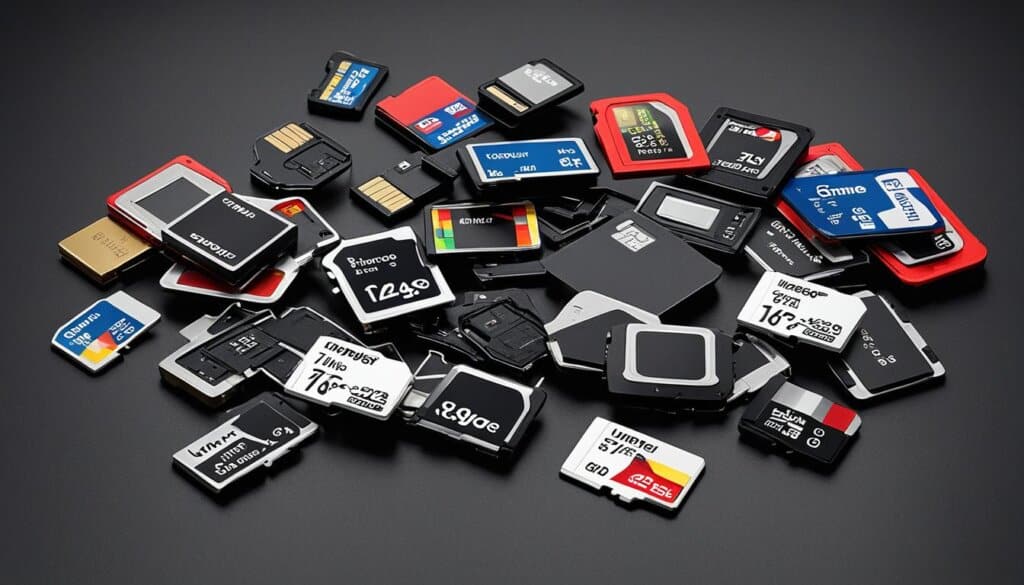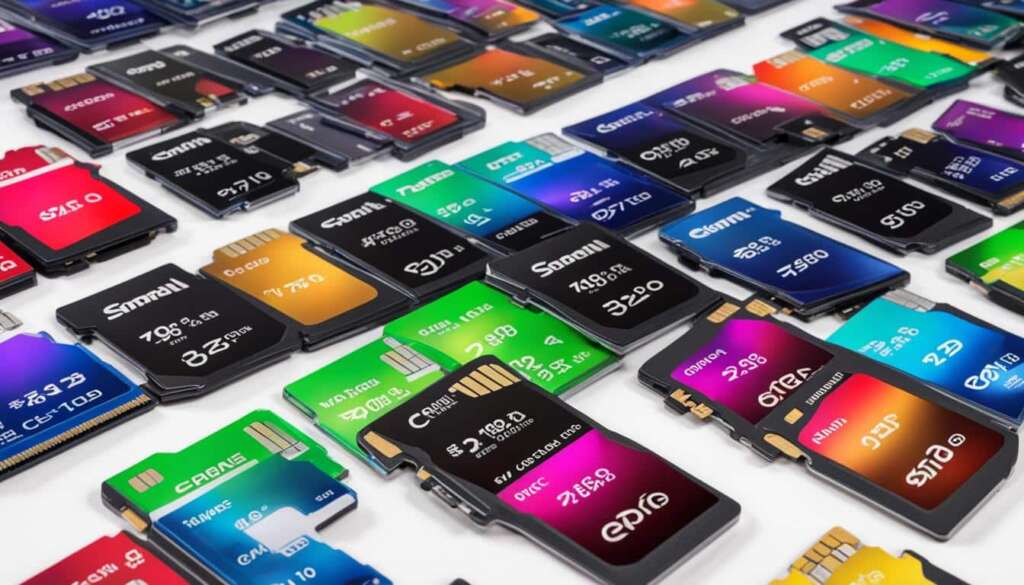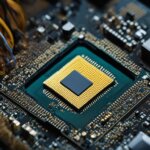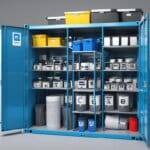Table of Contents
SD cards, also known as Secure Digital memory cards, are essential storage solutions for digital devices. Whether you’re a professional photographer or an avid smartphone user, SD cards play a crucial role in expanding your device’s memory and storing precious memories.
SD cards come in different types, including SD, SDHC, and SDXC, each offering varying capacities and file systems. These versatile storage options can range from a modest 64MB to a staggering 2TB, allowing you to store thousands of photos, videos, and other digital content.
When it comes to data transfer speeds, SD cards are no slouch either. With read and write speeds that determine how fast data can be transferred to and from the card, you can quickly access and transfer your files without any lag or delay.
To ensure optimal performance, SD cards also feature bus interfaces such as UHS-I and UHS-II, which determine the maximum speed at which data can be transferred. The speed class rating is another crucial aspect, especially for videographers, as it indicates the minimum sequential write speed required for shooting smooth and high-quality videos.
But that’s not all. Some SD cards even offer the Refresh Pro compatibility logo, which signifies compatibility with Refresh Pro software for checking card health and performance, providing you with peace of mind when it comes to the reliability and durability of your storage solution.
Whether you’re capturing special moments with your camera or expanding the storage on your smartphone, SD cards offer the perfect solution for your memory needs. With their versatility, capacity options, and impressive speed capabilities, SD cards are the go-to storage solution for anyone in need of reliable and portable storage options.
Types of Memory Cards
When it comes to choosing a memory card for your device, it’s important to understand the different types available. Let’s explore the most common memory card formats: SD, microSD, XQD, and CFexpress.
SD Cards
SD cards, also known as Secure Digital cards, are widely used and offer varying capacities and speeds. There are three main types of SD cards: SD, SDHC, and SDXC. These cards can store different amounts of data, ranging from a few megabytes to terabytes. SD cards also come with different bus interfaces, such as UHS-I and UHS-II, which affect the data transfer speed. Additionally, SD cards are classified into different speed classes, denoting their minimum sequential write speed.
MicroSD Cards
If you’re using a mobile device, chances are it supports microSD cards. These cards are smaller in size compared to standard SD cards but offer similar functionality. MicroSD cards are commonly used in smartphones, tablets, and action cameras, providing an expandable storage solution for your portable devices.
XQD and CFexpress Cards
XQD cards were introduced as a high-performance format, but they’ve been largely replaced by CFexpress cards. CFexpress cards offer faster transfer speeds compared to XQD and other memory card types. They are becoming increasingly popular, especially among professional photographers and videographers who require high-speed data storage for their demanding workflows.
Each type of memory card has its own unique dimensions and abbreviations, making it essential to choose the correct one for your device. Let’s take a closer look at the different memory card types:
| Memory Card Type | Dimensions | Abbreviation |
|---|---|---|
| SD | 32 x 24 x 2.1 mm | Secure Digital |
| microSD | 15 x 11 x 1 mm | Micro Secure Digital |
| XQD | 38.5 x 29.6 x 3.8 mm | Extended Qualification Design |
| CFexpress | 38.5 x 29.6 x 3.8 mm | CompactFlash Express |
Understanding the different types of memory cards will help you make an informed decision when selecting the right one for your device. Whether you need extra storage for your camera, smartphone, or other electronic devices, choose a memory card that suits your needs and supports the required data transfer speeds.
Understanding Memory Card Compatibility
When it comes to choosing a memory card for your digital camera, compatibility is key. The last thing you want is to invest in a memory card that your camera can’t read or use properly. To ensure a seamless experience, it’s important to understand the memory card compatibility requirements of your specific camera.
To determine the compatibility of a memory card with your digital camera, the first step is to consult the camera’s manual or the manufacturer’s website. These resources typically provide detailed information about the types of memory cards that are compatible with your camera model.
Some digital cameras are compatible with multiple types of memory cards, such as SD, microSD, or CompactFlash (CF) cards. These versatile cameras offer flexibility in choosing the memory card that suits your needs. On the other hand, some cameras require specific memory card formats, so it’s crucial to double-check what type of card your camera supports.
To simplify the process of choosing the right memory card for your digital camera, compatibility charts can be a valuable resource. These charts provide a comprehensive overview of camera models and the memory card types that are compatible with each model. By referring to a compatibility chart, you can quickly identify which memory cards are suitable for your camera without searching through extensive documentation.
Here is an example of a compatibility chart for popular digital camera brands:
| Camera Brand | Compatible Memory Card Types |
|---|---|
| Nikon | SD, microSD, XQD |
| Canon | SD, microSD, CompactFlash |
| Sony | SD, microSD, CFexpress |
| Fujifilm | SD, SDHC, SDXC |
By referring to this chart or similar resources, you can easily determine the memory card compatibility for your specific camera brand. This ensures that you choose a memory card that will work seamlessly with your camera and prevent any potential compatibility issues.
Remember, when it comes to memory card compatibility, it’s always better to be safe than sorry. Taking the time to research and understand your camera’s requirements will save you from the frustration of incompatible memory cards and ensure smooth performance when capturing and storing your precious memories.

The Future of Memory Cards
Memory card advancements continue to revolutionize the way we store and manage our digital media. With each new iteration, memory cards offer higher capacities and faster transfer speeds, catering to the ever-increasing demands of photographers, videographers, and tech enthusiasts.
One notable advancement in memory card technology is the introduction of SD Express. This new format pushes the boundaries of speed, allowing for even faster data transfer rates. Although SD Express has not yet been widely adopted, it holds great promise for the future of memory cards, offering enhanced performance and efficiency.
Another significant development in the field is the rise of CFexpress memory cards. These cards have emerged as a powerful alternative to older card types and are increasingly prevalent in high-end cameras. With faster write speeds and improved overall performance, CFexpress cards deliver the reliability and speed required for professional-grade photography and videography.
Looking ahead, there are exciting plans for the introduction of CFexpress Type C cards. These next-generation memory cards will boast larger capacities and even faster speeds, further expanding the possibilities for content creators. With increased storage space and lightning-fast transfer rates, photographers and videographers can confidently capture and store vast amounts of data without compromise.
FAQ
What is an SD card?
An SD card, or Secure Digital memory card, is a portable storage device used to store digital media such as photos and videos.
What are the different types of SD cards?
SD cards come in different types, including SD, SDHC, and SDXC, which indicate the range of capacity and file system used.
What is the capacity range of SD cards?
SD cards have different capacities ranging from 64MB to 2TB.
What do the read and write speeds of an SD card determine?
The read and write speeds of an SD card determine how fast data can be transferred to and from the card.
What are bus interfaces of SD cards?
SD cards have bus interfaces, such as UHS-I and UHS-II, which determine the maximum speed at which data can be transferred.
What does the speed class rating of an SD card indicate?
The speed class rating of an SD card indicates the minimum sequential write speed and is important for shooting videos.
What does the Refresh Pro compatibility logo on an SD card mean?
The Refresh Pro compatibility logo indicates compatibility with Refresh Pro software for checking card health and performance.
What are the most common memory card formats?
The most common memory card formats are SD, microSD, XQD, and CFexpress.
How are microSD cards different from SD cards?
MicroSD cards are smaller in size and are commonly used in mobile devices.
What are XQD cards and CFexpress cards?
XQD cards were introduced as a high-performance format but have been largely replaced by CFexpress cards, which offer faster transfer speeds.
How can I determine the memory card compatibility with my camera?
Memory card compatibility with your camera can usually be found by checking the camera’s manual or the manufacturer’s website.
Are all cameras compatible with multiple types of memory cards?
Some cameras are compatible with multiple types of memory cards, while others require specific formats.
Can compatibility charts help in determining the best memory card for my camera?
Yes, compatibility charts can be helpful in determining the best memory card for your camera.
What are the advancements in memory card technology?
Memory card technology continues to advance, offering higher capacities and faster transfer speeds.
What is SD Express?
SD Express is a new format that allows for even faster transfer speeds, although it has not been widely introduced yet.
How do CFexpress memory cards compare to older card types?
CFexpress memory cards offer increased performance compared to older card types and are becoming more common in high-end cameras.
Are there plans to introduce new memory card formats?
Yes, there are plans to introduce additional formats, such as CFexpress Type C, which will have larger sizes and faster speeds.
What do memory card advancements enable photographers and videographers to do?
Memory card advancements enable photographers and videographers to capture and store increasingly large amounts of data.













